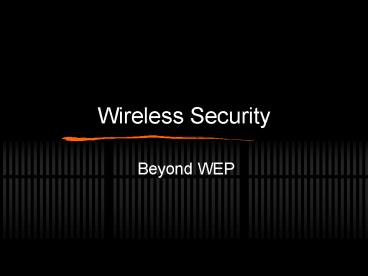Wireless Security - PowerPoint PPT Presentation
1 / 16
Title:
Wireless Security
Description:
Data Integrity (checksum, anti-tampering) WEP. RC4 stream cipher ... Message Integrity Code (MIC) - 64-bit message calculated using 'Michael' ... – PowerPoint PPT presentation
Number of Views:40
Avg rating:3.0/5.0
Title: Wireless Security
1
Wireless Security
- Beyond WEP
2
Wireless Security
- Privacy
- Authorization (access control)
- Data Integrity (checksum, anti-tampering)
3
WEP
- RC4 stream cipher
- WEP key (40 or 60 bit) combined with 24-bit
Initialization Vector (IV) - Sender XORs stream cipher with data to encrypt
- IV and ciphertext sent, decoded using IV and
stored WEP key
4
WEP Vulnerabilities
- Use of same WEP key among clients
- Limited keyspace for IV (16,777,215)
- With enough traffic, IVs are re-used
- Possible to collect packets with same IV and
crack WEP key - then open to data capture and
MITM attacks - No key management - WEP key must be changed
manually on each NIC
5
Attempts to secure WEP
- Larger WEP key length (Lucent 104/128-bit, Agere
152-bit, USRs 256-bit) - Just takes longer to retrieve WEP key
- VPN
- Can be difficult to achieve seamless routing when
APs are crossed
6
Wi-Fi Alliance introduces WPA
- 802.1X EAP mutual authentication or PSK
(Pre-Shared Key) - TKIP for encryption
- MMIC (Michael Message Integrity Check) for data
integrity
7
802.1X EAP Mutual Authentication
- Port-based access control
- Mutual authentication via authentication server
8
802.1X EAP has three elements
- Supplicant - client device
- Authentication Server - RADIUS server or similar
- Authenticator - intermediary between Supplicant
and Authentication server (usually an AP)
9
Different types of EAP
- LEAP - Cisco proprietary, uses username/password
to authenticate against RADIUS - TLS - RFC 2716, uses X.509 certificates for
authentication on both Supplicant and
Authenticator - TTLS - Developed by Funk Software, Authenticator
uses a certificate to identify itself, Supplicant
can use username/password - PEAP - Authenticator uses certificate, Supplicant
can use username/password
10
TKIP - Temporal Key Integrity Protocol
- Fixes the flaw of key reuse in WEP
- Comprised of three parts, guarantees clients us
different keys - - 128-bit temporal key, shared by clients and
APs - - MAC of client
- - 48-bit IV describes packet sequence number
11
TKIP continued
- Uses RC4 like WEP, so only software or firmware
upgrade required - Changes temporal keys every 10,000 packets
12
Michael Message Integrity Check (MMIC)
- Message Integrity Code (MIC) - 64-bit message
calculated using Michael algortithm inserted in
TKIP packet to detect content alteration - Protects both data and header
- Implements a frame counter, which discourages
replay attacks
13
Two modes of WPA
- WPA Enterprise
- WPA PSK (Pre-Shared Key)
14
WPA Enterprise
- Requires RADIUS server
- Uses RADIUS for both authentication and key
distribution - Central management
15
WPA PSK
- No RADIUS server required
- Uses shared secret
- Management is handled on the AP
- - Vulnerable to dictionary attacks
- - Still uses partial shared key
16
WPA Summary
- Requires authentication using 802.1X
- Keys change using TKIP
- Header as well as payload protected by adding MIC
to ICV - Frame counter to lower risk of replay attacks
- Still a temporary stopgap to 802.11i and/or WPA2
since it still uses RC4 and PSK uses shared key































